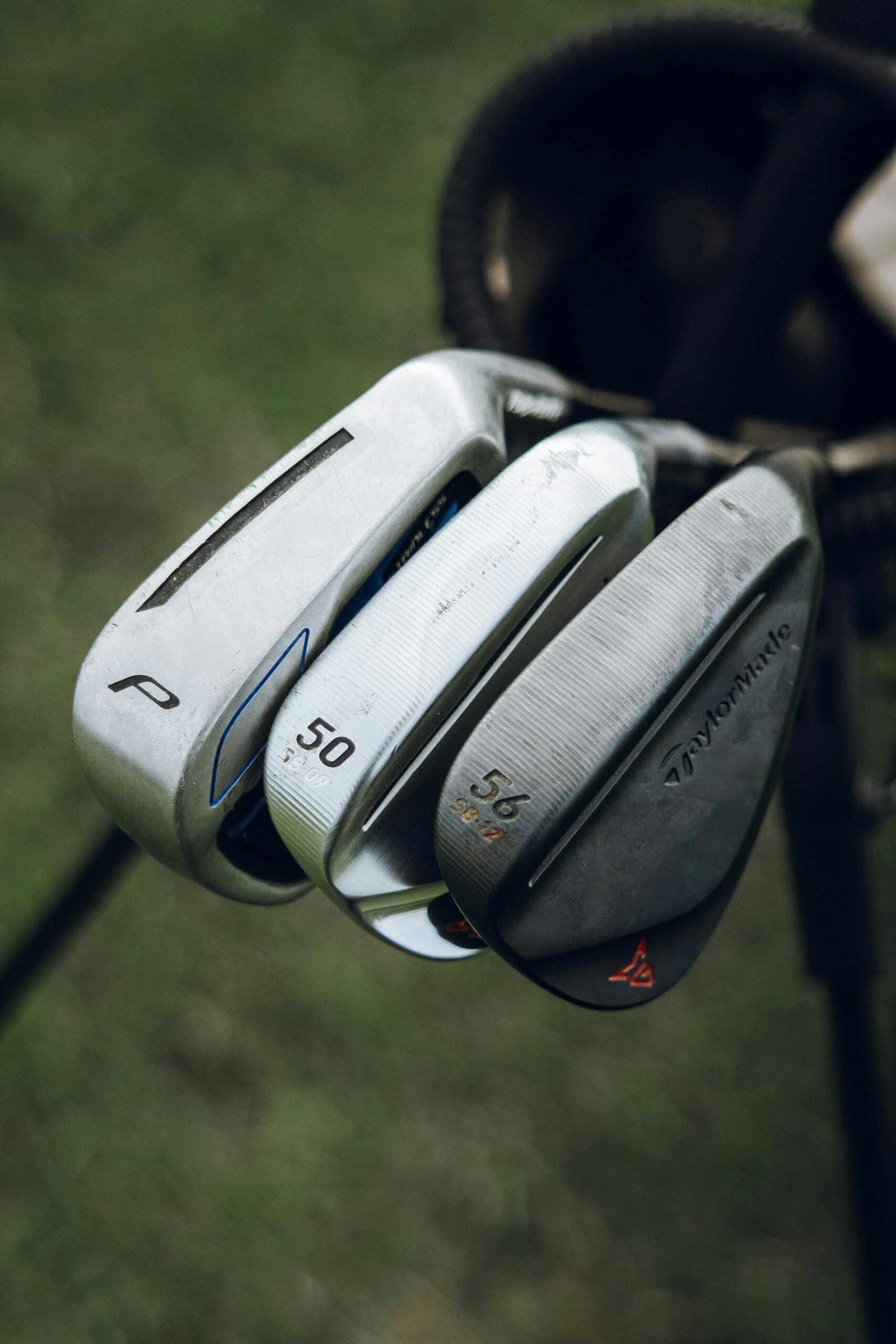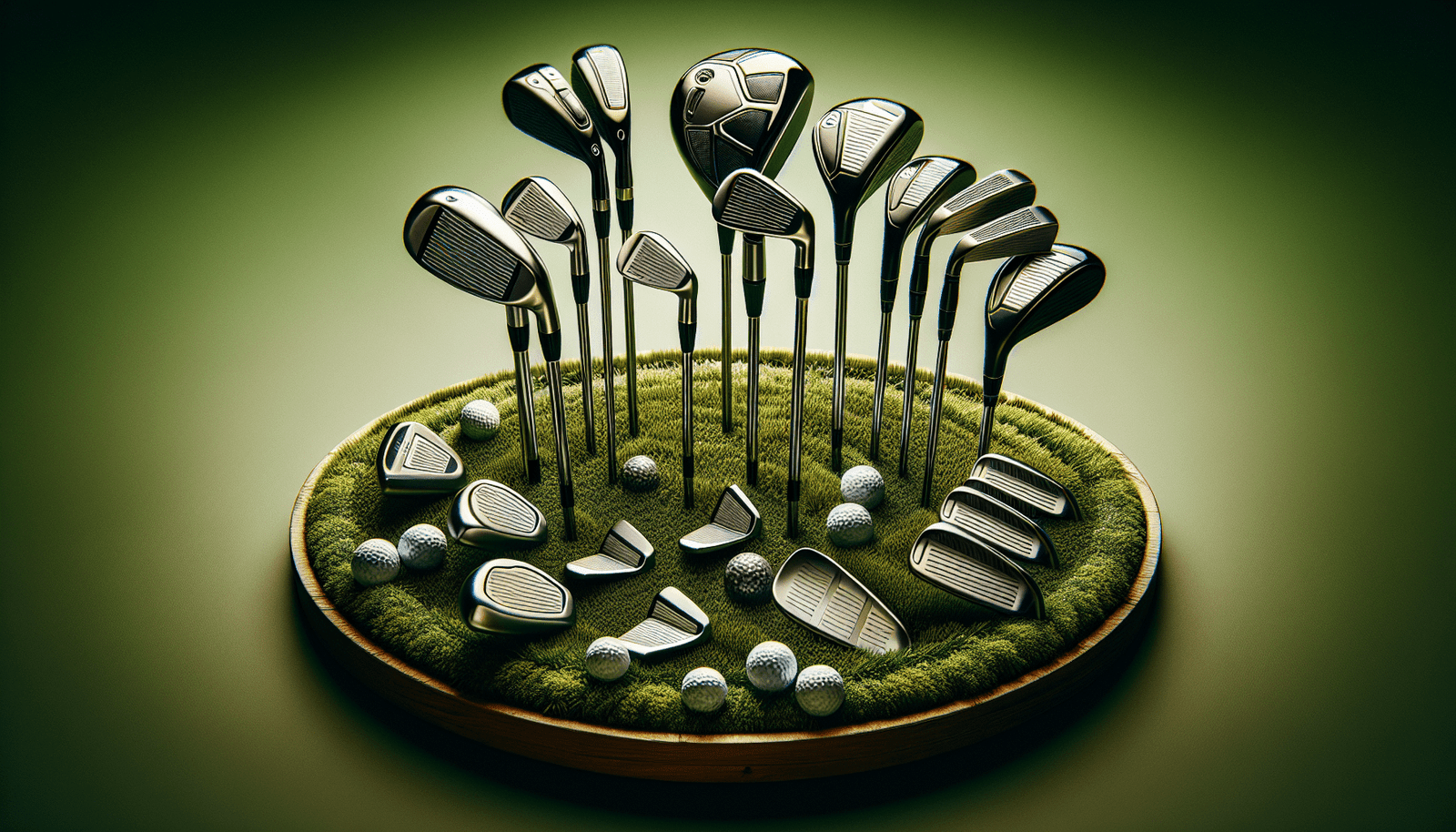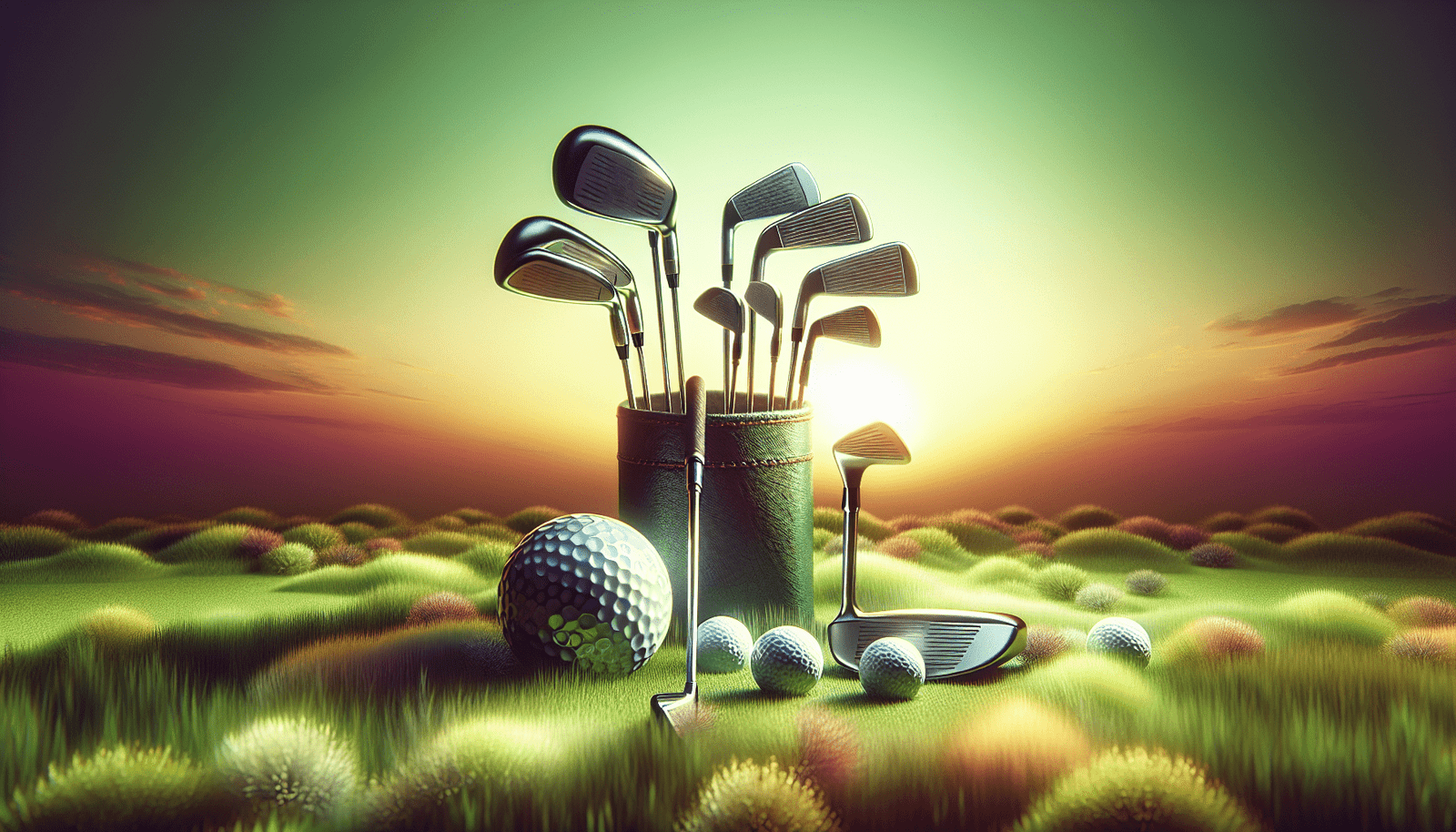
So you’ve recently caught the golf bug and you’re eager to hit the fairways and whack that little white ball into oblivion. But before you can start impressing your friends with your swing, there’s an important question you need to answer: what golf clubs do you need as a beginner? Don’t worry, we’ve got you covered. In this article, we’ll break down the essential golf clubs every beginner should have in their bag, helping you make the right choices to kickstart your golfing journey.
Types of Golf Clubs
When starting out in golf, it’s important to understand the various types of clubs that are available to you. Each club has its own unique purpose and design, and knowing when and how to use them can greatly improve your game. The five main types of golf clubs are drivers, irons, wedges, hybrids, and putters.
Drivers
Understanding the Purpose of a Driver
The driver is the club that is generally used for long-distance shots off the tee. It is designed with a large head and a long shaft to provide maximum distance. The purpose of a driver is to hit the ball as far as possible while maintaining control and accuracy. It is often used at the beginning of each hole to give you a good starting position and set you up for success.
Choosing the Right Driver
Choosing the right driver is crucial for beginners. It’s important to consider factors such as the loft, head size, and shaft flex. The loft refers to the angle of the clubface, and a higher loft can help beginners get the ball in the air easier. The head size also plays a role in forgiveness and distance potential. Finally, the shaft flex should match your swing speed and style.
Considerations for Beginner Golfers
As a beginner, you may want to consider using a driver with a higher loft and a more forgiving head design. These features can help you achieve better launch and distance while reducing the likelihood of mis-hits. Additionally, choosing a driver with an adjustable hosel can allow you to fine-tune the loft and face angle to suit your swing. Seeking advice from a professional or experienced golfer can also be beneficial in selecting the right driver for you.
Irons
Understanding the Purpose of Irons
Irons are the most versatile clubs in a golfer’s bag and are used for a wide range of distances and shots. They are typically used for mid-range shots from the fairway or rough. Irons have smaller heads and shorter shafts compared to drivers, offering better control and accuracy. The purpose of irons is to provide consistent distance, trajectory, and control.
Different Types of Irons
There are several types of irons, including the long irons (2-4), mid-irons (5-7), and short irons (8-9). The long irons are designed for longer shots and lower trajectory, while the mid-irons offer a balance between distance and accuracy. The short irons are used for shorter approach shots and have a higher loft for better control and stopping power. Additionally, there are also specialty irons such as pitching wedges and gap wedges, which have specific uses around the green.
Choosing the Right Irons for Beginners
For beginners, it is often recommended to start with a set of game improvement irons. These irons have a larger sweet spot and more forgiving design, which can help minimize the effects of off-center hits. Look for irons with perimeter weighting and cavity backs, as they provide added forgiveness and stability. As you progress and improve your skills, you can consider transitioning to a more player-oriented iron set.
Wedges
Understanding the Purpose of Wedges
Wedges are designed for shots that require high trajectory and a short distance. They are used when the golfer is close to the green and needs to make precise shots, such as bunker shots, chip shots, and pitch shots. Wedges are characterized by their high loft, allowing for increased control and spin.
Types of Wedges
There are four main types of wedges: pitching wedge (PW), sand wedge (SW), gap wedge (GW), and lob wedge (LW). The pitching wedge has the least loft among the wedges and is typically included in iron sets. The sand wedge is specifically designed to help golfers escape from bunkers and has a wide sole to prevent digging. The gap wedge fills the distance between the pitching wedge and sand wedge, while the lob wedge is used for high, short shots around the greens.
Selecting the Right Wedges for Beginners
For beginners, it is recommended to start with a pitching wedge and a sand wedge, as these two clubs will cover most of your short game needs. As you progress and become more comfortable with different shots, you can consider adding a gap wedge and lob wedge to your arsenal. It’s important to practice with each wedge to develop a feel for their different distances and trajectories.
Hybrids
Understanding the Purpose of Hybrids
Hybrids are a relatively new addition to golf clubs and are designed to combine the best features of both irons and woods. They are typically used as replacements for long irons and offer ease of use and forgiveness. Hybrids have a wider sole, lower center of gravity, and higher launch angle, making them ideal for hitting shots from challenging lies and long approach shots.
Why Hybrids are Beneficial for Beginners
Hybrids are beneficial for beginners because they are easier to hit and offer more forgiveness compared to long irons. Their design allows for a higher launch and longer carry distance, which can help beginners achieve better results with less effort. The wider sole and lower center of gravity also help with proper ball contact and reduce the chance of hitting fat or thin shots.
Selecting the Right Hybrids
When selecting hybrids, consider the loft, shaft flex, and clubhead design. The loft should be chosen based on the specific distance you want to achieve, and it’s important to have a consistent gap between your hybrid and other clubs in your bag. The shaft flex should match your swing speed for optimal distance and control. Finally, try out different clubhead designs to find one that suits your eye and inspires confidence at address.
Putters
Understanding the Purpose of Putters
Putters are the most important clubs in a golfer’s bag when it comes to scoring. They are used for shorter, delicate shots on the green to roll the ball into the hole. The purpose of a putter is to provide accurate direction, distance control, and consistency on the putting surface.
Different Styles of Putters
There are various styles of putters available, including blade putters, mallet putters, and counterbalanced putters. Blade putters have a traditional design and are favored by golfers who prefer a classic look and feel. Mallet putters have a larger and more forgiving head design, often with alignment aids on the clubhead. Counterbalanced putters have additional weight in the grip area, which helps promote a smoother stroke and reduce unwanted hand movements.
Choosing a Putter for Beginners
Choosing a putter that matches your stroke and personal preferences is crucial. It’s important to try out different styles and designs to find one that feels comfortable and suits your eye. Beginners may benefit from a putter with alignment aids on the clubhead and a larger sweet spot for improved forgiveness. Getting fitted for a putter can also help identify the correct length and lie angle for your stroke.
Considerations for Beginner Golfers
Budget
When starting out in golf, it’s essential to consider your budget. Golf clubs can vary greatly in price, and it’s important to find a set that fits within your financial means. While it’s tempting to invest in expensive equipment, there are plenty of affordable options available for beginners that can still provide excellent performance and durability.
Skill Level
Your skill level should also be taken into account when choosing golf clubs. As a beginner, you may not have developed a consistent swing yet and may need clubs that offer forgiveness and ease of use. Game improvement clubs, which are designed to help players with slower swing speeds and less experience, can be a great option for beginners looking to improve their game.
Golfing Style
Consider your preferred playing style when selecting golf clubs. If you enjoy playing a more aggressive game, you may want to choose clubs that offer more distance and control. On the other hand, if you prefer a more strategic and precise approach, clubs that provide more accuracy and feel may be better suited for you. Understanding and aligning your clubs with your playing style can enhance your overall golfing experience.
Golf Club Fittings
Getting fitted for golf clubs can greatly impact your performance on the course. A professional golf club fitting can help determine the correct club specifications for your individual swing characteristics and body measurements. By customizing factors such as club length, lie angle, and shaft flex, you can optimize your swing and maximize your potential.
Budget
Determining Your Budget
Before embarking on your golfing journey, it’s important to determine a budget for your golf clubs. Setting a budget will help guide your decision-making process and ensure you choose equipment that meets your financial constraints. Consider how much you are willing to spend on a complete set of clubs or individual clubs.
Evaluating Cost and Quality
When considering the cost of golf clubs, it’s important to balance the price with the quality and performance of the equipment. While high-end clubs may offer advanced technology and superior materials, there are also budget-friendly options available that can provide similar performance for beginners. Researching and reading reviews can help you make an informed decision and find clubs that offer good value for your budget.
Balancing Affordability and Performance
It’s important to find a balance between affordability and performance when selecting golf clubs as a beginner. While it may be tempting to invest in top-of-the-line equipment, it’s not necessary to break the bank to get started in golf. Many affordable club options offer excellent performance and can help you hone your skills without putting a strain on your budget. Remember, as you progress in the sport, you can always upgrade your clubs to suit your evolving game.

Skill Level
Assessing Your Skill Level
As a beginner, it’s important to assess your current skill level to determine the most suitable clubs for your game. Consider factors such as your swing speed, consistency, and ball-striking ability. Understanding your strengths and weaknesses can guide you towards clubs that will enhance your performance and improve your overall golfing experience.
Choosing Forgiving Clubs
Forgiving clubs are designed to be more forgiving on off-center hits, making them suitable for beginners who may have less consistency in their ball-striking. Look for clubs with a larger sweet spot, perimeter weighting, and cavity backs. These features can help minimize the effects of mis-hits and provide better distance and accuracy, even on less than perfect shots.
Adapting as You Improve
As you progress and improve your skills, you may find that your club preferences change. It’s important to adapt your equipment to your evolving game. Golf clubs that are suited for beginners may not provide the same level of performance as you become more adept at the sport. Be open to adjusting your club selection as your skills develop to ensure you maintain the best possible performance on the course.
Golf Club Fittings
Benefits of Club Fittings
Golf club fittings offer several benefits, regardless of your skill level. A professional club fitting can help identify the optimal club specifications for your swing, body measurements, and playing style. By customizing factors such as club length, lie angle, grip size, and shaft flex, you can ensure that your clubs are perfectly suited to your game. This can result in improved distance, accuracy, and overall performance on the course.
Working with a Professional
To get the most out of a club fitting session, it’s recommended to work with a professional club fitter or golf instructor. They have the knowledge and expertise to analyze your swing and recommend the best club options based on your unique characteristics. They can also provide guidance on swing mechanics and offer valuable insights to help you improve your game.
Customizing Clubs for Maximum Performance
Customizing your clubs through a fitting session allows you to optimize their performance. Properly fitted clubs can help you achieve optimal distance, accuracy, and consistency by ensuring that each club in your bag complements your swing and playing style. This personalized approach can make a significant difference in your overall golfing experience, regardless of your skill level.
In conclusion, as a beginner golfer, it’s important to understand the different types of golf clubs and their purposes. Drivers, irons, wedges, hybrids, and putters all serve different functions and can greatly impact your game. When selecting clubs, consider factors such as your budget, skill level, and golfing style. Seek professional advice and consider getting fitted for clubs to optimize your performance on the course. With the right clubs in your bag, you’ll be well-prepared to enjoy the game of golf and improve your skills as you progress.
